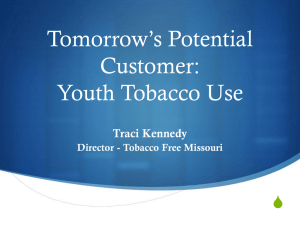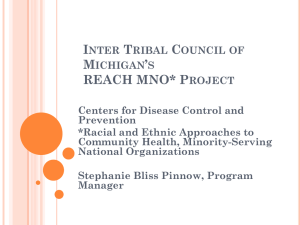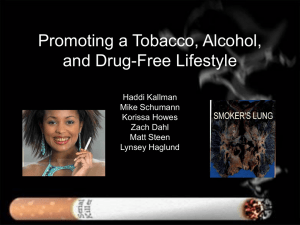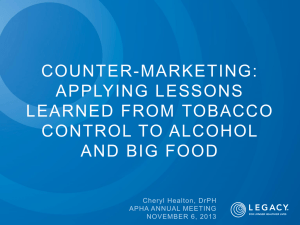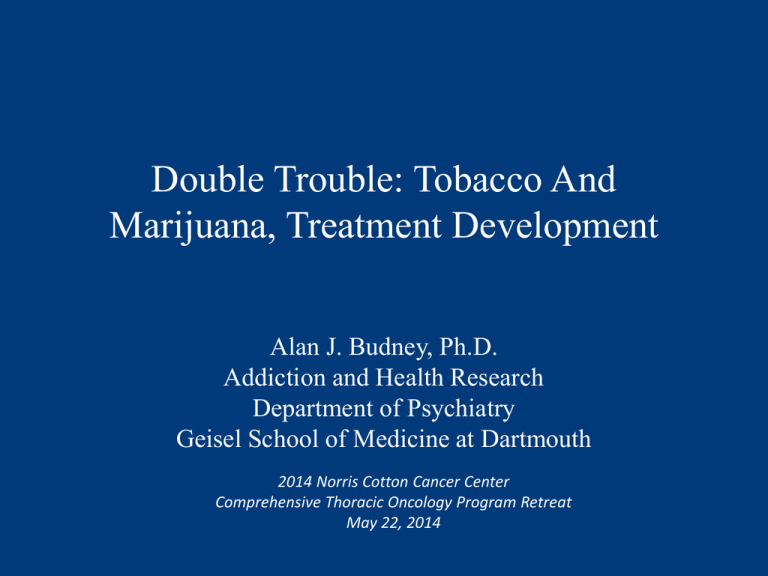
Double Trouble: Tobacco And
Marijuana, Treatment Development
Alan J. Budney, Ph.D.
Addiction and Health Research
Department of Psychiatry
Geisel School of Medicine at Dartmouth
2014 Norris Cotton Cancer Center
Comprehensive Thoracic Oncology Program Retreat
May 22, 2014
Disclosures
Research supported by NIH (NIDA)
• NIDA R01-DA032243
– (Targeting Tobacco and Cessation During Treatment for Cannabis Use Disorders)
• NIDA R01-DA012471
– (Treatment of Adolescent Marijuana Use)
• NIDA T32-DA037202
– (Science of Co-Occurring Disorders)
- Limited Consultation with GW Pharmaceuticals/Otsuka (2011)
- Participation in Pharmaceutical Company Trials (1995-2004)
Outline
• Prevalence of cannabis (marijuana) use and
problematic use
• Prevalence of and concerns with co-use of
tobacco and marijuana
• Clinical approaches to treatment
• Current pilot study
• Discussion
Past Month Illicit Drug Use among Persons
Aged 12 or Older: 2012
SAMHSA, 2013
Dependence or Abuse on Specific Drugs in the Past
Year Among Persons 12 or Older, (2012)
SAMHSA, 2013
Substances for Which Most Recent Treatment Was
Received in the Past Year (Aged 12 or Older)
SAMHSA, 2013
Marijuana and Tobacco Co-Use
Past Year Use
Cannabis users reporting cigarette use
Prevalence
64.8%
Past Month
Cannabis users reporting cigarette use
60.5%
Dependence
Cannabis dependence with tobacco dependence
34%
SAMHSA, 2013
Approximately 50% of adults in treatment for cannabis use
disorders (CUD) report concurrent tobacco use
Patterns of Co-Use
• Tobacco use onset has typically preceded marijuana use; but
not always and some indication that this trend is changing
• Smoked together (blunts, spliffs, vapor pens or pipes)
• Chasing: smoke a cigarette immediately after marijuana
• Separately: smoke marijuana, use tobacco as usual, no
intentional mixing
The Future??
Mechanisms Underlying Co-Use?
–Common and reciprocal genetic pathways to co-use
• Evidence from twin studies suggests heritability
• CNR1 polymorphism associated with nicotine dependence
–Pharmacological interactions (increase reinforcing effects)
• Endocannabinoid system is involved in the reinforcing effects
of nicotine
• Marijuana users report tobacco use enhances the marijuana high
Mechanisms Underlying Co-Use?
• Common route of administration
– both substances typically inhaled by smoking
(vaporizing)
– may increase learned associations between substances
through conditioned smoking cues signaling availability of
reinforcement from the other substance
• Understanding neurobiological or behavioral
mechanisms underlying co-use may improve
treatments
Concerns of Co-Use
- Social, psychological, and physical impairments related to use
- Substantial public-health costs due to tobacco-related illnesses
and death
- Targeting only cannabis still leaves the substantial negativehealth related consequences of tobacco use
- Co-use Impacts Treatment Outcomes
- Use of one can negatively impact quit rates for the other
- Tobacco smoking is a predictor of poor outcomes for those
in treatment for cannabis use disorders
- Cannabis use among tobacco smokers predicts continued
long term tobacco use
Cannabis and Respiratory System and Cancer Risk
Gates et al. (2014)
• Why should we be concerned
– Cannabis smoke contains similar array of carcinogens to
tobacco smoke (e.g. increased tar, ammonia, hydrogen cyanide)
– Smoking topography: prolonged and deep inhalation
• 5-fold increase in carboxyhemoglobin
• 4-fold increase in tar inhaled; 30% more retention in lower airway
– Quantity, frequency, and duration of use are associated with
respiratory problems
– A lot we don’t know: dose effects, impact of different
cannabinoids (e.g., CBD)
– Data are not clear that it has additive effects to tobacco
Cannabis and Respiratory System and Cancer Risk
– Bronchial dynamics (acute effect: bronchodialator)
– Results in airway inflammation and infection
• Increased bronchitis and seeking of Rx for respiratory illness
• Higher frequency cough, sputem production, and wheezing
– Equivocal data on COPD and related indicatior (FEV,
FCV) and Emphysema (sparse literature)
– Lung Cancer
• Some support for a link between cannabis use and
cancer risk, but
• Suggest link between use and premalignant cancer
• Link to development of lung cancer remains weak
– Link to “heavy” use more positive
Treatment for Cannabis Use Disorder
• Effective behavioral treatments for CUD:
• Gold Standard: Combination of Cognitive
Behavioral Therapy (CBT) and Contingency
Management (CM)
Typical Program
- 12 Weeks
- Weekly Counseling Sessions
- Abstinence-based Incentives
Motivational Incentives (CM) Improve Outcome
% of Participants Abstinent
MET/CBT
MET/CBT/CM
CM
50
40
30
20
10
0
ETX
3
6
9
Months Post Treatment
Budney et al. (2006)
12
Percentage of Participants
Computer-Assisted Treatment
Budney et al. (in prep)
What about Tobacco in this Population?
• Tobacco users (50%) have poorer outcomes
• Almost none quit tobacco during treatment
• Negative health consequences of tobacco use
Suggested that targeting tobacco use might be an
option for increasing treatment success and reducing
harm from tobacco
Potential Approaches to Combining Interventions
• Approaches for integrating treatments
– sequential (cannabis treatment first, then offer
treatment for tobacco)
– simultaneous (treat both at the same time)
Tobacco Intervention
• Combination behavioral counseling (computerassisted) and pharmacotherapy
• NRT was chosen over other pharmacotherapies for
tobacco two reasons:
1) varenicline and bupropion have side effects profiles that
may increase symptoms of cannabis withdrawal
2) NRT is available without a prescription; easier to access
We provide Patch, Gum, Lozenges
NIDA R01
• Aims
– develop and pilot test a treatment program
providing an intervention for tobacco during
treatment for CUD
– conduct an initial randomized trial
Cannabis MET/CBT Computer Modules
• Modules 1 and 2 (MET)
– an interactive review of a personalized feedback report
– goal-setting exercises, including setting a quit date
• Modules 3–8 (CBT)
–
–
–
–
–
–
–
–
–
developing an effective social support system,
understanding use patterns,
coping with craving, managing thoughts about using,
problem solving,
refusal skills,
coping with lapses,
managing moods,
assertiveness skills,
lifestyle goal-setting exercise.
• The last module encourages participants to revisit helpful computer
modules, and to remotely access the relapse prevention module in
the future.
Tobacco Intervention
5 computer modules (10-30 min each)
– personalized assessment - Stop Tabac (Etter, 2009)
– Psychoeducation: co-use of cannabis and tobacco
– NRT education and instruction;
– planning for change/setting a quit date;
– reduction strategies
Sample of a cumulative progress graph (i.e. cumulative weeks
negative cannabis urine screens)
Stop Tobacco: Personalized Feedback Report
Email Messages
Intended to motivate
and provide specific
instructions based
upon responses to the
personalized
questionnaire
Participants
• Inclusion Criteria:
– adult (> 18 years old) cannabis users seeking
treatment for cannabis who also smoke tobacco
regularly
– meet DSM-IV diagnosis for cannabis abuse or
dependence
– at least some interest in quitting tobacco (> 2 on a
5 pt scale)
Participant Demographics
Demographic
Mean (SD)
N
14 enrolled
Age
35.4 (14.1)
Gender
12 Male/2 Female
Drug Use History
Mean (SD)
Age of Initiation
Cannabis
15.7 (3.3)
Tobacco
15.0 (3.3
Prior Quit Attempts
Cannabis
3.6 (4.0)
Tobacco
3.5 (3.6)
Tobacco Dependence (FTND)
3.0 (2.4)
Drug Use (past 90 days)
Mean (SD)
Cannabis occasions per day
3.2 (1.2)
85/90 days
Tobacco cigarettes per day
11.2 (8.2)
83/90 days
Pilot Study Hypotheses
1)
90% would complete the first tobacco module.
2)
>40% would set tobacco smoking quit dates and initiate NRT.
3)
Tobacco quit attempts:
>35% would make at least one tobacco quit attempt (>24 hrs);
>25–30% would achieve two weeks of continuous abstinence;
>15–25% would be tobacco abstinent during the final 4–6 weeks.
4)
<10% would report adverse effects of NRT that led to
discontinuation.
5)
>35–40% would achieve >4 weeks of documented continuous
cannabis abstinence during treatment.
Summary of Outcomes
1)
12 out of 14 participants completed at least one tobacco module
(mean = 2.2 modules).
2)
3 out of 14 participants set a quit date, and 8 out of 14 initiated
NRT.
3)
Tobacco quit attempts:
10 of 14 made at least one quit attempt lasting at least 24 hrs,
5 made quit attempts lasting at least two weeks,
1 was tobacco abstinent for the final four weeks of treatment.
4)
No participant discontinued NRT use due to adverse effects.
5)
6 out of 14 participants achieved >4 weeks of documented
continuous cannabis abstinence (mean = 9.5 weeks)
Cannabis and Tobacco Outcomes
Cannabis and Tobacco Outcomes
Cannabis and Tobacco Outcomes
Summary
• Preliminary fidnings from the pilot:
– the tobacco intervention is not adversely impacting
cannabis outcomes;
– the majority participated in the tobacco intervention and
showed substantial interest in quitting or reducing
– sustained tobacco quit rates are lower than anticipated, but
participants are reducing use and attempting to quit tobacco
Alternative Strategies
• Decision Support System Task (Mary Brunette, M.D.)
– web-based interactive assessment
• Subsequent incentive program for tobacco abstinence
– Add an 8-week incentive program targeting both for those
who quit cannabis but not tobacco
• Increase utilization of Stop Tabac (i.e. encourage use
of supportive emails, setting a quit date)
• Additional pharmacological options (i.e. varenicline,
buproprion)
Final Comments
• Marijuana use is likely to increase
• Higher potency marijuana will be used
• Combined nicotine/tobacco/cannabis products will be
developed and marketed
• May become gateway for tobacco / nicotine
• Vaporizers / e-cigs e-pens / will have impact on
prevalence of use and co-use....consequences are
unclear
• How all this will impact your field.....IDK
Acknowledgements
Co-Investigators
Clinic Staff Members
•
•
•
•
•
•
•
•
•
•
Dustin Lee, Ph.D.
Catherine Stanger, Ph.D.
Mary Brunette, M.D.
John Hughes, M.D.
Jean-Francois Etter, Ph.D.
Kathy Marshall, M.S.
Gray Norton, B.A.
Stanley See, B.S.
Hao Yang, B.S.
William Pelham III
Funding: National Institute on Drug Abuse: R01 DA032243
Thank you for your attention!
Questions?




